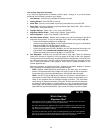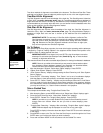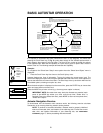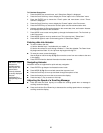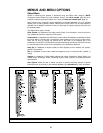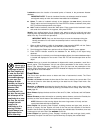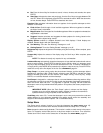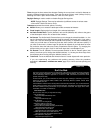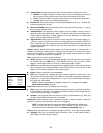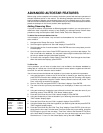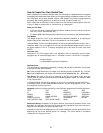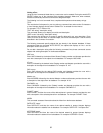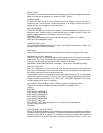
27
Time changes the time entered into Autostar. Setting the correct time is critical for Autostar to
properly calculate locations and events. Time may be set to 24-hour mode (military time) by
selecting the "blank" option which follows the "AM" and "PM" options.
Daylight Saving is used to enable or disable Daylight Savings time.
NOTE: Daylight Savings Time may be referred to by different names in various areas
of the world. Check local time to verify.
Telescope accesses the several options, including:
■ Model: Allows you to select the telescope model connected to Autostar.
■ Focal Length: Displays the focal length of the selected telescope.
■ Az Ratio and Alt Ratio: The Az (Azimuth) ratio and Alt (Altitude) ratio refers to the gears
of the telescope's motors. Do not alter these numbers.
■ Az Percent: The Az (Azimuth) Percent allows you to change the azimuth backlash, i.e., the
way the Arrow keys move the telescope along the azimuth (horizontal) axis. If you enter a
value near 100, the telescope tube responds more quickly (it responds immediately at
100%) as you hold down an Arrow key and also slews (moves) the tube more quickly. If
you enter a value near 0, it takes longer for the tube to respond as you hold down an Arrow
key and also slews the tube more slowly. Experiment with this option. Try changing the
percent value until you get a "feel" for the Arrow keys that is comfortable for you.
■ Alt Percent: The Alt (Altitude) Percent operates identical to the Az Percent option (see
above), but allows you to change the altitude backlash, i.e., the way the Arrow keys move
the telescope when moving along the altitude (vertical) axis.
■ Train Drive: Trains the Altitude and Azimuth motors to locate objects with more precision.
If you are experiencing any problems with pointing accuracy, follow the procedure
described in
APPENDIX C:TRAINING THE DRIVE, page 43, to insure accurate pointing and
tracking.
DSX TIPS
Surf the Web
One of the most exciting resources for astronomy is the internet. The internet is full of websites
with new images, discoveries, and the latest astronomical information. For example: When
comet Hale-Bopp made its approach to our Sun in 1998, astronomers around the world
posted new photos daily.
On the internet, you can find websites for almost any topic relating to astronomy. Try the fol-
lowing key word searches: NASA, Hubble, HST, astronomy, Messier, satellite, nebula, black
hole, variable stars, etc.
Check Meade’s website for the latest product and technical information. You can download the
latest software revisions, links to other astronomical sites, coordinates of celestial objects and
the latest satellite tracking information for your Autostar II handset. See page 28 for more
information. You’ll find our website at:
www.meade.com/
Here are some other sites you might find interesting:
• Sky & Telescope:
http://www.SkyandTelescope.com
• Astronomy:
http://www.astronomy.com
• The Starfield:
http://users.nac.net/gburke/
• Astronomy Picture of the Day:
http://antwrp.gsfc.nasa.goc/apod
• Heavens Above (satellite observing information):
http://www.heavens-above.com
• Photographic Atlas of the Moon:
http://www.lpi.ursa.edu/research/lunar_orbiter
• Hubble Space Telescope Public Pictures:
http://oposite.stsci.edu/pubinfo/pictures.html
• Jack Horkheimer, Stargazer:
http://www.jackstargazer.com/



